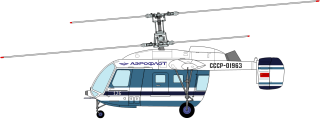
The Yakovlev Yak-24 is a Soviet twin-engine, tandem rotor, transport helicopter developed by Yakovlev in the 1950s. The Yak-24 saw limited use in the Soviet Air Force, and the exact number produced and duration of service are unknown due to inconsistencies in data.

The Mil Mi-34 is a light helicopter designed by the Mil Moscow Helicopter Plant in either a two or four seat configuration for utility and training. It was first flown on 17 November 1986 and introduced at the Paris Air Show in 1987. The Mi-34 entered production in 1993, and is capable of performing aerobatic manoeuvres, including rolls and loops.

The Mil V-12, given the project number Izdeliye 65, is a prototype helicopter designed in the Soviet Union and the largest helicopter ever built. The designation "Mi-12" would have been the designation for the production helicopter and did not apply to V-12 prototypes.

The Mil Mi-6, given the article number izdeliye 50 and company designation V-6, is a Soviet/Russian heavy transport helicopter that was designed by the Mil design bureau. It was built in large numbers for both military and civil use and was the largest helicopter in production until the Mil Mi-26 was put in production in 1980.

The Mil Mi-1 was a Soviet three- or four-seat light utility helicopter. It was the first Soviet helicopter to enter serial production. It is powered by one 575 hp (429 kW) Ivchenko AI-26V radial piston engine. It entered service in 1950 and was first seen on the 1951 Soviet Aviation Day, Tushino and was produced for 16 years. More than 1,000 were built in the USSR and 1,594 in Poland, as SM-1.

The Kamov Ka-26 is a Soviet light utility helicopter with co-axial rotors.

The Kamov Ka-15 was a Soviet two-seat utility helicopter with coaxial rotors, which first flew on 14 April 1952 at the hands of test pilot D. K. Yefremov. It was the world's first mass-produced coaxial helicopter. State acceptance trials were completed in 1955, and the helicopter entered production the following year at aircraft factory No. 99 in Ulan-Ude. It was a precursor to the Ka-18 and was fitted with the M-14 engine. It was primarily used for bush patrol, agricultural purposes and fishery control.

The PZL Kania is a follow-up design to the Mil Mi-2 helicopter, developed in Poland by PZL-Świdnik.

The Seibel S-4 was a two-bladed, single-engine helicopter built by Seibel Helicopter. Designed by Charles Seibel, the S-4 was evaluated by the United States Army under the designation YH-24 Sky Hawk, but would be rejected for service. The S-4B would serve as the basis for the design of the Cessna CH-1 Skyhook, the only helicopter Cessna ever produced.

The Bell R-12 was an American 1940s military utility helicopter built by the Bell Helicopter company.

The BŻ-4 Żuk, formerly known as GIL-4, was a Polish four-seat light helicopter built in the 1950s. Although it pioneered a novel rotor and transmission system, it never entered series production.

The Bratukhin Omega was an early Soviet helicopter, the first product of a new Soviet design bureau, OKB-3 that was created from within TsAGI specifically to develop rotary-wing aircraft. Bratukhin's design was a side-by-side twin rotor machine, with each rotor carried on a long outrigger truss. The Omega's rotors were each powered by a separate engine carried in a nacelle also at the end of the truss. Captive trials commenced in August 1941 and revealed severe problems with engine vibration and overheating. Before these could be addressed, however, OKB-3 was evacuated ahead of the German advance into the Soviet Union.

The Mil Mi-54 was a projected twin-turbine civil utility helicopter, first announced in 1992, intended to replace the Mi-2 and the Mi-8 helicopters. It was planned to use two 574 kW Saturn/Lyulka AL-32 turboshaft engines, four-bladed main and tail rotors, and fixed tricycle-type landing gear with one nosewheel and two rear wheels on sponsons.

The Yakovlev EG (Eksperimentalnyi Gelikopter), also commonly known as the Yak-M11FR-1 and Sh (Shootka), was an experimental aircraft with coaxial rotors. The prototype was first flown by V.V. Tezavrovsky in December 1947.

The Kamov Ka-126 is a Soviet light utility helicopter with co-axial rotors. Evolved from Ka-26 with engine pods removed from stub wings, fitted with one TVO-100 turboshaft engine positioned on top of fuselage, modified rotor blades, new fuel system.

The Yakovlev Yak-100 was a single-engine transport helicopter developed in the USSR in 1948. This was the Yakovlev Design Bureau's second helicopter.

The Canadian Home Rotors Safari is a kit helicopter, produced by CHR International of Marianna, Florida, and formerly produced by Safari Helicopter of Ear Falls, Ontario.

The Borgward BFK-1 Kolibri, or Borgward-Focke BFK-1 Kolibri, was a German three-seated utility helicopter built by Borgward, designed by Heinrich Focke and was the first German helicopter after World War II. The helicopter first flew on 8 July 1958 in Bremen, piloted by Ewald Rohlfs.

The Harbin/CHDRI Z-6,, is a Chinese helicopter development based on the Harbin Z-5, itself a licence-built / reverse engineered Mil Mi-4. A limited production run was terminated after performance was found to be inferior to its Z-5 progenitor.
The AVIC AC332 is a Chinese civil helicopter that is under development by the Aviation Industry Corporation of China (AVIC). The AC 332's chief designer at AVIC is Li Shengwei. The aircraft is intended to be type certified for production.


















